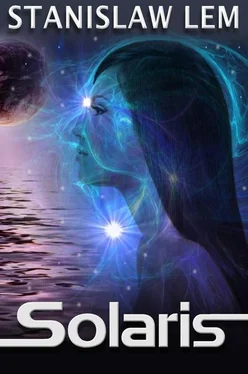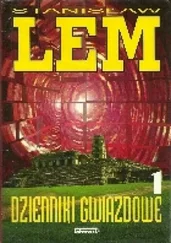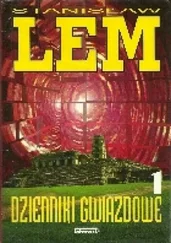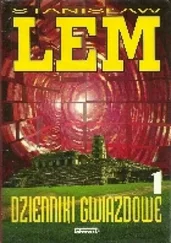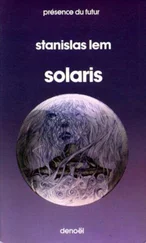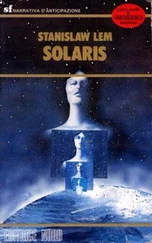In this way it was physicists, not biologists, who proposed the paradoxical formulation “plasmic machine” to refer to a formation that in our sense might be devoid of life, but was capable of undertaking purposive actions on a scale that, let us add at once, was astronomical.
In this dispute, which in the space of weeks sucked in every leading authority like a whirlwind, the Gamov-Shapley hypothesis was brought into question for the first time in eighty years.
For a period efforts were made to defend it by asserting that the ocean had nothing to do with life, that it wasn’t even a “parabiological” or “pre-biological” formation, but a geological entity, no doubt of an unusual kind, but whose only capability was to preserve Solaris’s orbit through changes in gravitational pull (reference was made to Le Châtelier’s principle).
To counter this conservatism there arose suggestions such as the Civita-Vitty hypothesis, one of the better constructed, claiming that the ocean was the product of a dialectical development: starting from its original form, that of a proto-ocean, a solution of sluggishly interacting chemical substances, under the pressure of conditions (meaning the orbital changes that threatened its existence), without passing through all the terrestrial stages of development — that is to say, the emergence of protozoa and metazoa, plant and animal evolution. Without developing a nervous system, it had been able to jump directly to the phase of a “homeostatic ocean.” Put simply, unlike terrestrial organisms it did not adapt to its surroundings over the course of hundreds of millions of years, so as only then to produce a rational species, but it had gained control over its environment from the start.
This was highly original, except that it was still the case no one knew how a syrupy jelly could stabilize the orbit of a celestial body. For almost a century there had existed devices that created artificial force fields and gravitational fields — gravitors — but no one could even imagine how the effects a gravitor achieves through a complex series of nuclear reactions and extremely high temperatures could be accomplished by an amorphous ooze. In the newspapers — which in those days, to the delight of their readers and the despair of scientists, reveled in the most indiscriminate conjectures concerning the “enigma of Solaris”—there were claims that the planetary ocean was a distant relative of earth’s electric eel.
When the problem was at least in some measure cleared up, it transpired that as was so often the case with Solaris, one mystery had been replaced with another that was perhaps even more puzzling.
Research revealed that the ocean did not operate at all like our gravitors (which, of course, would have been impossible), but that it was capable of directly modeling space-time specifications, which led among other things to variations in the measurement of time at one and the same meridian on Solaris. In this way the ocean not only in a certain sense knew the Einstein-Boeve hypothesis, but (unlike us humans) was even able to make use of its consequences.
When this emerged, one of the most tempestuous storms of our century broke out in the scientific world. Some of the most venerable theories, universally regarded as correct, collapsed in ruins, the most heretical articles began to appear in the scientific literature, and the “brilliant ocean” versus “gravitational jelly” debate set every mind on fire.
All this happened a good fifteen or so years before I was born. When I was at school, thanks to facts discovered later, Solaris was widely regarded as a planet endowed with life — but with only a single inhabitant…
The second volume of Hughes and Eugel, which I was still abstractedly thumbing through, opened with a taxonomy that was as original as it was amusing. A classification table showed the following:
Type: Polytheria
Order: Syncytialia
Class: Metamorpha .
It was as if we knew goodness knows how many specimens, whereas in reality there was still only one, which admittedly weighted seventeen billion tons.
I flipped past colored diagrams and graphs, analyses and spectrographs setting out the class and tempo of basic metabolism and its chemical reactions. The deeper I immersed myself in the bulky tome, the more mathematics appeared on its chalk-white pages. It might have seemed that our knowledge of this representative of the class of Metamorpha , which lay swathed in the darkness of its four-hour night a thousand or so feet below the steel bed of the Station, was complete.
In reality, however, not everyone agreed that this was a “being,” quite aside from the question of whether an ocean could be called rational. I plonked the big book back on the shelf and took down the next volume. It was divided into two parts. The first constituted a summary of the results of all the innumerable experiments aimed at making contact with the ocean. As I remember only too well, this contact was the source of endless anecdotes, witticisms, and jokes when I was in school; medieval scholastics seemed a model of clarity compared with the jungle that this matter gave rise to. The second part of the volume, comprising almost thirteen hundred pages, contained nothing but a bibliography. There would not have been space in the room I was in for all the original literature on the topic.
The first attempts at contact employed special electronic devices that transformed stimuli sent in both directions. The ocean played an active part in the design of the devices — though all this happened in complete darkness. What does it mean to say it “played an active part”? It modified certain components of the equipment lowered into it, as a result of which the discharges it registered would change, and the devices would record a multitude of signals that were like fragments of some vast advanced analysis. But what did it all mean? Perhaps these data captured a temporary state of excitation of the ocean? Perhaps they were impulses that gave rise to its immense creations, somewhere thousands of miles from the researchers? Perhaps they were expressions of the ocean’s eternal truths, converted into inscrutable electronic formulations? Perhaps they were its works of art? Who could know, since it was never possible to produce the same reaction to a stimulus twice? Since one time the response would be an explosion of impulses that almost blew the apparatus up, the next time profound silence? Since no experiment could ever be replicated? It always seemed as if we were on the brink of deciphering this constantly accumulating sea of readings; it was for this purpose that electronic brains were constructed with the ability to process more information than had ever been required by any problem before now. And, in fact, certain results were obtained. The ocean — a source of electrical, magnetic, and gravitational impulses — spoke as it were in the language of mathematics; certain sequences of its electrical discharges could be classified by drawing on the most abstract branches of terrestrial analysis and of set theory; they contained homologues of structures known from the area of physics that is concerned with the mutual relationship between energy and matter, finite and infinite magnitude, particles and fields. All this led scientists to believe they were dealing with a thinking monster, that it was some kind of protoplasmic sea- cum -brain grown so vast it covered an entire planet, which passed time engrossed in theoretical reflections on an inconceivable scale concerning the nature of the universe; and that what the instruments captured were no more than tiny, accidentally overheard snippets of a stupendous monologue, utterly beyond our comprehension, that was endlessly being performed in its depths.
Читать дальше
